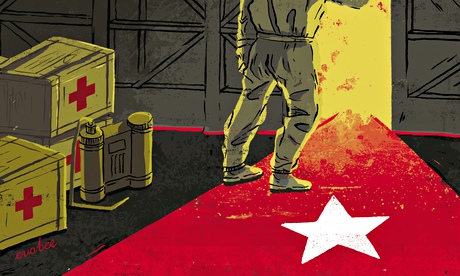Report on Allende's death was part of inquiry into hundreds of murders committed by Pinochet regime in Chile
By Guy Adams
Thursday, 21 July 2011
Thursday, 21 July 2011
Salvador Allende, the Chilean president who was widely considered to be the world's first democratically elected Marxist, committed suicide 37 years ago, and was not murdered by right-wing revolutionaries, according to the results of a post-mortem unveiled yesterday.
A forensic team in Santiago, which has been examining Allende's exhumed body for the past two months, concluded that he died from injuries consistent with having turned an AK47 assault rifle on himself. They found no evidence to support theories that a third party was involved.
The detailed report was welcomed by Allende's family, who have always maintained that the 65-year-old politician took his own life as troops stormed La Mondea, the country's Presidential Palace, during a US-backed coup on 11 September 1973.
"The conclusions are consistent with what we already believed," his daughter, Senator Isabel Allende, told reporters. "When faced with extreme circumstances, he made the decision of taking his own life, instead of being humiliated or having to go through with some other situation."
On the day of the coup, Allende, who had voiced hostility to the US and formed diplomatic alliances with Cuba and Russia, is reported to have promised supporters that he would not be taken alive, even as La Mondea was bombed by fighter jets and filled with smoke and tear gas.
Yet for years, left-wing conspiracy theorists, including Allende's old friend and comrade Fidel Castro, have maintained that he was murdered by bloodthirsty revolutionaries. They claimed his corpse, which was never shown to his family, was riddled with bullets, and argued that an "official" autopsy carried out on the night of the coup was rigged.
Adding to the sense of mystery about the death was the fact that neither the weapon (which had been a gift to Allende from Castro) nor one of the two fatal bullets, were ever recovered. The incoming administration never carried out a criminal investigation, and for years the Allende family had refused to sanction another autopsy.
In May, however, a team of coroners and forensic experts were finally authorised by Isabel to examine the former president's corpse. They were unable to uncover any evidence to support murder allegations, and said his injuries were consistent with a self-inflicted wound from a rifle held between his legs.
"There were two bullets fired at the scene; two shells were recovered, but only one bullet," said David Pryor, a former Scotland Yard expert in forensic ballistics who worked as a consultant on the case. "The gun, an AKA rifle, was on automatic. There was one wound in his skull, caused by two bullets."
The 20-page report on Allende's death was commissioned by a judge investigating hundreds of murders and other human rights abuses committed by the regime of General Augusto Pinochet, whose right-wing military dictatorship presided over the country for almost two decades after the 1973 coup.
Pinochet, who seized power with the tacit support of the US, and held onto it with the backing of Lady Thatcher's Conservative administration, is accused of being responsible for the murder or "disappearance" of more than three thousand political opponents.
A forensic team in Santiago, which has been examining Allende's exhumed body for the past two months, concluded that he died from injuries consistent with having turned an AK47 assault rifle on himself. They found no evidence to support theories that a third party was involved.
The detailed report was welcomed by Allende's family, who have always maintained that the 65-year-old politician took his own life as troops stormed La Mondea, the country's Presidential Palace, during a US-backed coup on 11 September 1973.
"The conclusions are consistent with what we already believed," his daughter, Senator Isabel Allende, told reporters. "When faced with extreme circumstances, he made the decision of taking his own life, instead of being humiliated or having to go through with some other situation."
On the day of the coup, Allende, who had voiced hostility to the US and formed diplomatic alliances with Cuba and Russia, is reported to have promised supporters that he would not be taken alive, even as La Mondea was bombed by fighter jets and filled with smoke and tear gas.
Yet for years, left-wing conspiracy theorists, including Allende's old friend and comrade Fidel Castro, have maintained that he was murdered by bloodthirsty revolutionaries. They claimed his corpse, which was never shown to his family, was riddled with bullets, and argued that an "official" autopsy carried out on the night of the coup was rigged.
Adding to the sense of mystery about the death was the fact that neither the weapon (which had been a gift to Allende from Castro) nor one of the two fatal bullets, were ever recovered. The incoming administration never carried out a criminal investigation, and for years the Allende family had refused to sanction another autopsy.
In May, however, a team of coroners and forensic experts were finally authorised by Isabel to examine the former president's corpse. They were unable to uncover any evidence to support murder allegations, and said his injuries were consistent with a self-inflicted wound from a rifle held between his legs.
"There were two bullets fired at the scene; two shells were recovered, but only one bullet," said David Pryor, a former Scotland Yard expert in forensic ballistics who worked as a consultant on the case. "The gun, an AKA rifle, was on automatic. There was one wound in his skull, caused by two bullets."
The 20-page report on Allende's death was commissioned by a judge investigating hundreds of murders and other human rights abuses committed by the regime of General Augusto Pinochet, whose right-wing military dictatorship presided over the country for almost two decades after the 1973 coup.
Pinochet, who seized power with the tacit support of the US, and held onto it with the backing of Lady Thatcher's Conservative administration, is accused of being responsible for the murder or "disappearance" of more than three thousand political opponents.

